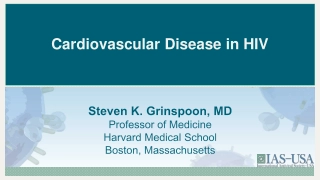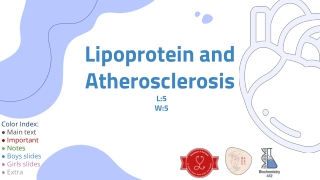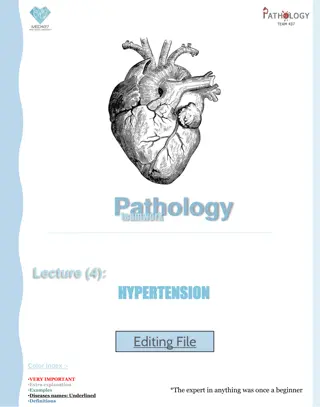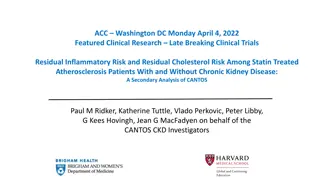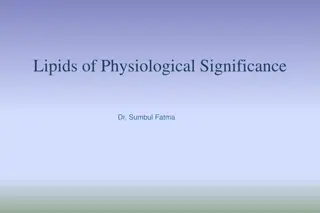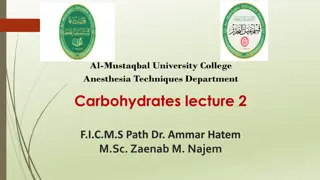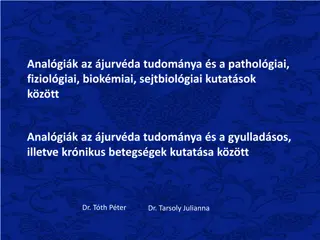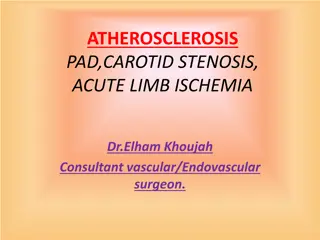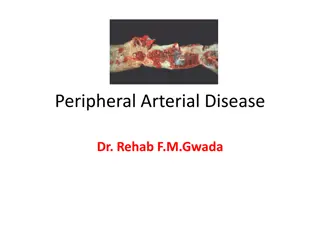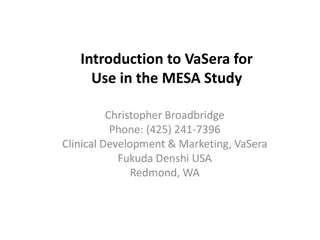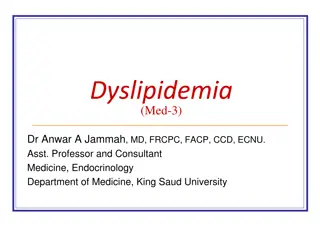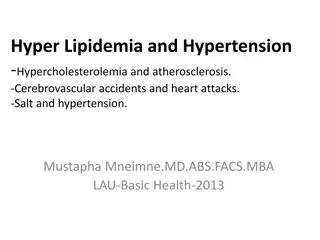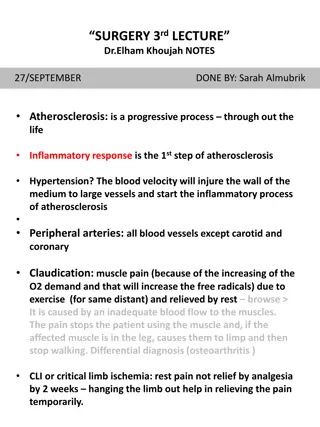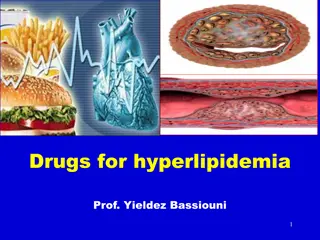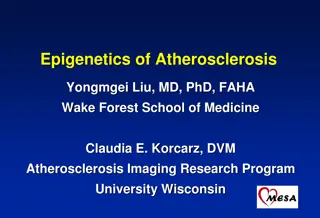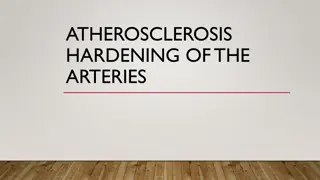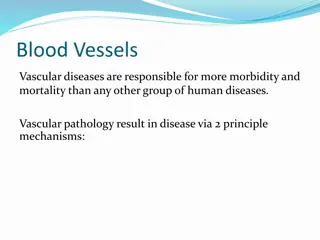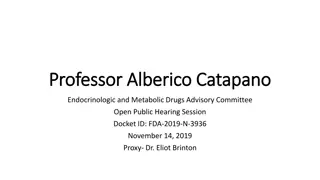
Understanding Atherosclerosis: Symptoms, Causes, and Prevention
Learn about atherosclerosis, a condition where plaque buildup in arteries can lead to complications like heart attacks and strokes. Discover the types, symptoms, causes, and prevention methods to safeguard your heart health.
Download Presentation

Please find below an Image/Link to download the presentation.
The content on the website is provided AS IS for your information and personal use only. It may not be sold, licensed, or shared on other websites without obtaining consent from the author. If you encounter any issues during the download, it is possible that the publisher has removed the file from their server.
You are allowed to download the files provided on this website for personal or commercial use, subject to the condition that they are used lawfully. All files are the property of their respective owners.
The content on the website is provided AS IS for your information and personal use only. It may not be sold, licensed, or shared on other websites without obtaining consent from the author.
E N D
Presentation Transcript
StudyMafia.Org Atherosclerosis Submitted To: Submitted By: Studymafia.org Studymafia.org
Content What Is Atherosclerosis? Types of Atherosclerosis? Symptoms Causes Risk Factor Diagnosis Prevention Treatment Complications
What Is Atherosclerosis? Atherosclerosis is a disease that happens when plaque builds up on the inside walls of your arteries. Arteries are blood vessels that deliver blood and oxygen from the heart to the rest of the body. Plaque is a sticky substance made of fat, cholesterol, calcium and other substances. As plaque builds up, your arteries become hard and narrow.
Types of Arteriosclerosis Atherosclerosis: In this type, the large arteries are hardened and narrowed. Moenckeberg medial calcific sclerosis: The hardening of small to medium-sized arteries. Arteriolosclerosis: The calcification of small arteries.
Symptoms Even as artery walls gradually thicken and stiffen, there usually are no arteriosclerosis symptoms. Even as the condition worsens into atherosclerosis, mild cases may still show no symptoms. That s why regular checkups are important. As arteriosclerosis progresses, clogged arteries can trigger a heart attack or stroke, with the following symptoms: Chest pain or pressure (angina) Sudden arm or leg weakness or numbness
Slurred speech or difficulty speaking Brief loss of vision in one eye Drooping facial muscles Pain when walking High blood pressure Kidney failure If you experience any of these heart attack or stroke symptoms, see your physician right away.
Causes A number of factors can contribute to arteriosclerosis. Arteriosclerosis causes include: High cholesterol High blood pressure High triglycerides Insulin resistance or diabetes Obesity Smoking or use of other tobacco products Inflammation from other diseases
Risk Factors Risk factors that could contribute to arteriosclerosis include: Family history: People with a family history of heart disease or arteriosclerosis are at higher risk for the condition. Age Cardiovascular diseases History of smoking
Diagnosis Your doctor will start with a physical exam. They ll listen to your arteries and check for weak or absent pulses. You might need tests, including: Angiogram, in which your doctor puts dye into your arteries so they ll be visible on an X-ray. Ankle-brachial index, a test to compare blood pressures in your lower leg and arm. watch your heart rate, blood pressure, and breathing.
Blood tests to look for things that raise your risk of having atherosclerosis, like high cholesterol or blood sugar. CT scan or magnetic resonance angiography (MRA) to look for hardened or narrowed arteries. EKG, a record of your heart s electrical activity. Stress test, in which you exercise while health care professionals
Prevention While some causes and risk factors like age and heredity cannot be controlled, there are ways you can help to prevent arteriosclerosis: Practice good heart health: Eat a healthy diet, exercise and avoid smoking. Take your medications as prescribed: If you have high blood pressure, high cholesterol or diabetes, be certain to take your prescribed medications as directed.
Treatment Treatment for arteriosclerosis includes a healthy diet, exercise and medication to control or possibly reverse your condition. If enlarged blood vessels have been diagnosed, our goal is to develop an individualized treatment plan so blood clots do not form. Medication Medications to treat arteriosclerosis are prescribed based on the location of your enlarged blood vessels and other underlying conditions you may have. Arteriosclerosis treatment medications include: Cholesterol medications can protect your heart arteries.
Aspirin can prevent platelets from forming blood clots. Beta blocker medications can reduce your blood pressure and heart rate and diminish chest pains, the risk of heart attack and irregular heart rhythm. Angiotensin-converting enzyme (ACE) inhibitors can lower blood pressure and lower the possibility of heart attack. Calcium channel blockers and diuretics (water pills) can reduce blood pressure. A clot-busting drug may dissolve blood clots. Your physician may also prescribe other medications, based on your needs. It is imperative that you monitor your blood pressure and take medications daily as prescribed to lower the possibility of complications.
Complications Coronary Arteriosclerosis (Coronary artery disease): Narrowed arteries near the heart may lead to chest pain, heart attack or heart failure. Peripheral artery disease: Narrowed arteries in the arms or legs may cause circulation problems that make it difficult to feel heat and cold, and cause gangrene that can lead to limb amputation.
Carotid artery disease: Narrowed arteries near the brain may cause transient ischemic attack (TIA) or stroke. Aneurysms: A bulge in the wall of an artery, if it bursts, can cause a slow leak or life- threatening internal bleeding. Chronic kidney disease: Narrow arteries near the kidneys can prevent effective kidney function.
Conclusion In summary, arteriosclerosis is mostly due to ageing. There are no symptoms and as such, no cure. But, some lifestyle changes such as aerobic exercises, healthy diet, optimal blood pressure maintenance, and stress management can minimize the chances of early development. The arterial stiffness could lead to atheroma formation in the vessel leading to atherosclerosis.
Thanks To StudyMafia.org

